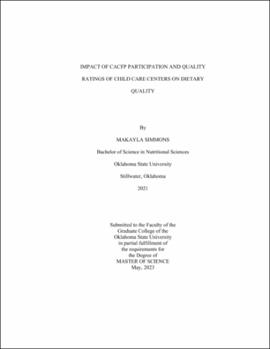| dc.contributor.advisor | Hildebrand, Deana | |
| dc.contributor.author | Simmons, Makayla | |
| dc.date.accessioned | 2023-08-25T20:06:30Z | |
| dc.date.available | 2023-08-25T20:06:30Z | |
| dc.date.issued | 2023-05 | |
| dc.identifier.uri | https://hdl.handle.net/11244/338960 | |
| dc.description.abstract | Introduction/Review of Literature: The average Healthy Eating Index-2015 (HEI-2015) score for children aged 2-17 years is 53.9/100, indicating that children’s diets do not align with federal dietary recommendations. Dietary quality (DQ) impacts nearly all aspects of life, including overall health, development of disease-related risk factors, academic performance, and more. The nutrition provided to children needs to be improved to reap the benefits of DQ. Improving nutrition within child care centers may offer a solution. This study examined the average DQ of posted lunch menus served at Oklahoma child care centers. Methodology: This study involved a cross-sectional content analysis of 10-day/2-week posted lunch menus from Oklahoma child care centers and a 10-day/2-week best practice (BP) lunch menu. Posted menus were obtained through snowball sampling, and the BP menu was created to achieve the highest possible HEI scores while also being feasible to implement and serve. Nutrient content was assessed using nutrient analysis software and DQ using the HEI-2015. Findings: The obtained menus represented 12 Child and Adult Care Food Program (CACFP)-participating, 8 non-CACFP-participating, 9 Three Star rated, and 11 non-Three Star rated child care centers, as assessed by the quality rating improvement system (QRIS) in Oklahoma, Reaching for the Stars. The BP lunch menu scored 18.3 points (29.25%) higher in total HEI score and higher within all HEI components, compared to the posted lunch menus, with differences in whole grains and total score. No differences were found between the HEI scores of posted lunch menus served at CACFP-participating and non-CACFP-participating nor between Three Star rated and non-Three Star rated child care centers. Conclusion: This study shows that CACFP participation and quality ratings of child care centers do not impact DQ, revealing areas for improvement within policy and organizations. Improvements include enhancing current child care center meal planning practices and incorporating nutrition quality as a component of quality of care within state QRIS’. These improvements could increase the healthfulness of the foods served within child care centers, improve the nutrition provided to children, and thus support children’s overall health and academic performance and help prevent the development of disease-related risk factors. | |
| dc.format | application/pdf | |
| dc.language | en_US | |
| dc.rights | Copyright is held by the author who has granted the Oklahoma State University Library the non-exclusive right to share this material in its institutional repository. Contact Digital Library Services at lib-dls@okstate.edu or 405-744-9161 for the permission policy on the use, reproduction or distribution of this material. | |
| dc.title | Impact of CACFP participation and quality ratings of child care centers on dietary quality | |
| dc.contributor.committeeMember | Joyce, Jill | |
| dc.contributor.committeeMember | Amaya, Lauren | |
| osu.filename | Simmons_okstate_0664M_18006.pdf | |
| osu.accesstype | Open Access | |
| dc.type.genre | Thesis | |
| dc.type.material | Text | |
| dc.subject.keywords | CACFP | |
| dc.subject.keywords | child and adult care food program | |
| dc.subject.keywords | child health | |
| dc.subject.keywords | child nutrition | |
| dc.subject.keywords | dietary quality | |
| dc.subject.keywords | nutrition | |
| thesis.degree.discipline | Nutritional Science | |
| thesis.degree.grantor | Oklahoma State University | |
